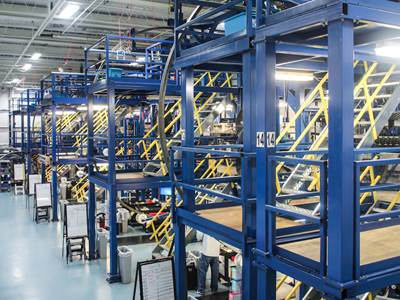DARPA pursuing new composite material and process
DARPA’s Tailorable Feedstock and Forming (TFF) program is seeking a tailorable short-fiber composite feedstock that is stampable and moldable and yields aerospace-grade properties.
Its widely known that the manufacturing process for defense systems—from aircraft to vehicles to ships—is extremely complex and fragmented, often demanding unique materials and processes, complex certification requirements and specifications and specialized tools and equipment. But according to The Defense Advanced Research Projects Agency (DARPA), part of the U.S. Department of Defense (DoD), the manufacture of diverse small parts for military systems could be made simpler, faster and less expensive with the development of a tailorable composite feedstock material and a single tailorable forming method.
To achieve this goal, DARPA has launched its Tailorable Feedstock and Forming (TFF) program, which aims to reduce the time and cost burdens associated with current manufacturing design and development cycles for defense platforms. TFF aims to cut the turnaround time for part modifications and redesigns by as much as 50 percent.
Composite materials are extremely strong and lightweight, but automated systems for producing composite parts are currently cost-effective only for parts weighing 20 pounds or more. Parts weighing less than 20 pounds are usually manufactured using metals, such as aluminum, which cost less than composites but are more dense, adding weight to the system.
“Eighty percent of small parts are made of metal due to the prohibitive fabrication cost of composite parts under 20 pounds,” said Mick Maher, program manager in DARPA’s Defense Sciences Office. “Although metal parts are cheaper to make, their additional weight leads to sub-optimal performance of the system. Through TFF, we aim to develop a versatile composite material and an adaptable forming process to allow affordable fabrication of multiple part configurations from the same work cell.”
TFF has two main focus areas—how to make aerospace composite materials more affordable and how to process this new material into useable product form, Maher said. In current composite manufacturing, developing the tools to process materials into products takes a significant amount of time. Any design changes in the platform require redesign of the tools resulting in significant cost and schedule delays. “Tooling processes can take six to twelve months per design cycle, significantly pushing out the timeline for production,” Maher said. “By developing flexible forming solutions to allow for multiple parts from one work cell, we believe we can shorten the tooling and production cycle for parts—which typically includes an initial design and two re-design periods—down to three years, from today’s average of about six years.”
The TFF program is seeking a tailorable short-fiber composite feedstock that is stampable and moldable and yields aerospace-grade properties. TFF also seeks technologies to create a tailorable forming work cell capable of manufacturing multiple part configurations with minimal reconfiguration costs and allowing rapid fabrication cycle time.
“If we’re successful, this program should reduce the weight of military systems by making composite parts as affordable as metal, eliminate the lengthy and costly re-tooling burden, and open new design space for small composite parts,” Maher said.
The TFF program seeks expertise in fiber development, resin formulation and composite processing. The Broad Agency Announcement (BAA) solicitation is available on FedBizOpps here: http://go.usa.gov/3ebtH
Related Content
Manufacturing the MFFD thermoplastic composite fuselage
Demonstrator’s upper, lower shells and assembly prove materials and new processes for lighter, cheaper and more sustainable high-rate future aircraft.
Read MoreCombining multifunctional thermoplastic composites, additive manufacturing for next-gen airframe structures
The DOMMINIO project combines AFP with 3D printed gyroid cores, embedded SHM sensors and smart materials for induction-driven disassembly of parts at end of life.
Read MorePlant tour: Albany Engineered Composites, Rochester, N.H., U.S.
Efficient, high-quality, well-controlled composites manufacturing at volume is the mantra for this 3D weaving specialist.
Read MorePlant tour: Joby Aviation, Marina, Calif., U.S.
As the advanced air mobility market begins to take shape, market leader Joby Aviation works to industrialize composites manufacturing for its first-generation, composites-intensive, all-electric air taxi.
Read MoreRead Next
“Structured air” TPS safeguards composite structures
Powered by an 85% air/15% pure polyimide aerogel, Blueshift’s novel material system protects structures during transient thermal events from -200°C to beyond 2400°C for rockets, battery boxes and more.
Read MoreModeling and characterization of crushable composite structures
How the predictive tool “CZone” is applied to simulate the axial crushing response of composites, providing valuable insights into their use for motorsport applications.
Read MorePlant tour: A&P, Cincinnati, OH
A&P has made a name for itself as a braider, but the depth and breadth of its technical aptitude comes into sharp focus with a peek behind usually closed doors.
Read More


























